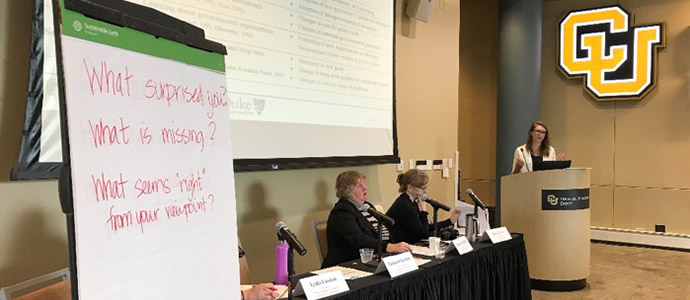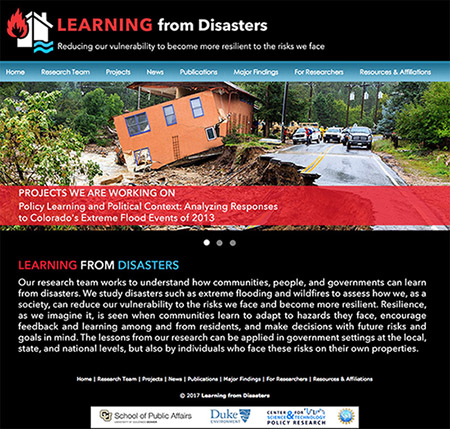Learning from Colorado’s 2013 Floods: Decisions, Processes, and Outcomes Four Years Laterby Deserai Crow and Elizabeth Albright |
| The CSTPR blog, Prometheus, was revived in 2016 to regularly feature content from CSTPR core faculty, research associates, postdocs, visitors, students and affiliates to serve as a resource for science and technology decision makers. This new dynamism reflects the new energies and pursuits taking place in and around CSTPR. Below we feature one of the recent Prometheus blog posts. |
Elizabeth Koebele (Assistant Professor at University of Nevada Reno), former CSTPR graduate student and RA on the flood project, presents at the concluding stakeholder workshop for flood study participant communities in September 2017. Photo: Deserai Crow. |
Nearly five years ago this coming fall, a stationary storm settled on Colorado’s Front Range foothills, dropping more than 16 inches of rain over 72 hours in some places. Flash flooding along foothills communities (Boulder, Lyons, Longmont, Estes Park, and Loveland, among others) occurred within hours. As the flood waters moved east, Colorado’s plains communities (Evans and Greeley, among others) were impacted. Communities, households, and individuals are vulnerable to floods due to factors such as human development and changing weather patterns associated with climate change. Local governments focus much of their preparedness attention on emergency response, such as evacuation and restoration of utilities, and may assume that those skills can translate into longer-term disaster recovery. However, during disaster recovery, local governments are faced with a myriad of policy challenges, from repairing and replacing infrastructure to broader questions of reducing vulnerability to future hazards, which must be dealt with over months and years with no clear path toward ‘success’. Understanding how local governments respond to a disaster and plan for the future is critical to consider in order to determine whether experiencing a disaster results in safer and more resilient communities. Our work is focused on what leads to increased community resilience to future disasters. We have spent the last four years focused on understanding how communities, the public, and governments can learn from disasters. Resilience, as we define it in our study, is seen when communities learn to adapt to hazards they face, encourage feedback and learning among and from residents, and make decisions with future risks and goals in mind. The goal of our study is to help communities learn how to improve recovery decisions that decrease their vulnerability to a wide variety of hazards and prepare for future disasters that may strike. Hazards in this case include flood risk, but can also include natural, human-made, accidental, economic, or other risks that communities face. The difference between ongoing vulnerability to hazards and long-term resilience may, in part, depend on learning from and adaptating to disaster risks in local communities. Residents and decision makers who understand the factors that increase the likelihood of successful resilience policy may be more likely to develop long-term local-level adaptability and resilience. While communities learn most dramatically from their own experience with disasters, we believe our research can help communities that face myriad hazards establish processes that can mitigate their risk for future disasters. Based on our research findings, we presented the following recommendations to local governments working on disaster recovery planning at a fall workshop with our research participants. Risk Perception, Communication, and Community Participation
Needs of Diverse Communities
Financial and Budgetary Planning
Visit the research team’s website at http://www.learningfromdisasters.org for a full report and publications. The full report of our project findings is available at our project website. Our hope is that local governments can use the recommendations to move towards a more resilient state in the face of ongoing and increasing hazards. Drs. Crow and Albright thank the study participants who gave generously of their time over three years, collaborator Dr. Todd Ely, and research assistants Dr. Lydia Lawhon, Dr. Elizabeth Koebele, Dr. Jack Zhou, Corrie Hannah, and Daniel Kojetin. This project was funded by the National Science Foundation and pilot data were collected through a quick response grant from CU’s Natural Hazards Center. Deserai Crow, deserai.crow@ucdenver.edu |



